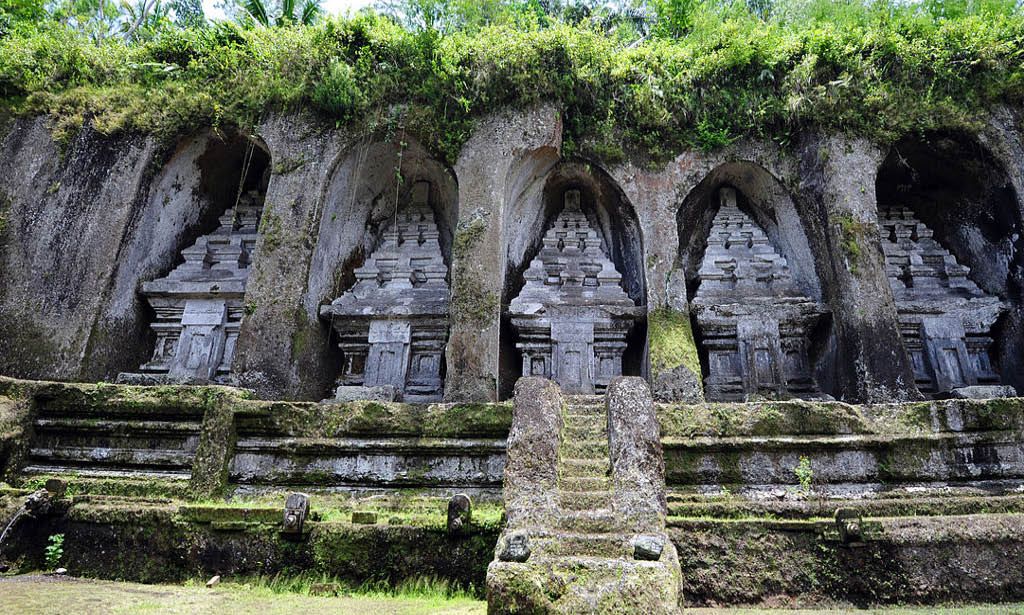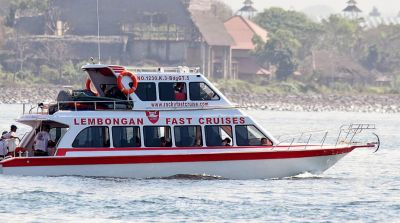Deskripsi
Lembah Raja-raja Bali sendiri adalah Gunung Kawi Temple di Tampaksiring. Kumpulan candi ini terletak di lembah sungai yang dikelilingi oleh sawah dan hutan. Ini telah menjadi salah satu perjalanan favorit kami selama bertahun-tahun.
Gunung Kawi Temple adalah kumpulan sepuluh candi, diciptakan untuk menyerupai penampilan bangunan kuil dan dirancang untuk menyediakan tempat tinggal bagi jiwa raja-raja kuno. Candi-candi ini dipahat ke dalam dinding lembah di kedua sisi Sungai Pekerisan. Gunung Kawi Temple memiliki sejarah yang menarik. Prasasti di atas setiap Candi menunjukkan perkiraan tanggal pembangunan pada abad ke-11. Dipercayai bahwa setiap kuil berfungsi sebagai tugu peringatan untuk seorang raja yang dideifikasi terutama karena mereka berbentuk seperti menara pemakaman, atau Candi, yang ditemukan di seluruh Jawa Tengah. Namun di Jawa mereka berdiri bebas sedangkan yang ditemukan di Gunung Kawi sebenarnya adalah relief yang dipahat di batu padat. Meskipun asal muasal candi tersebut tidak diketahui, ada bukti yang menunjukkan bahwa lima set pertama dibangun untuk menghormati Raja Anak Wungsu, yang pemerintahannya di Bali bagian tengah dan timur berlangsung dari AD 1050 hingga sekitar AD 1080. Kemungkinan satu dibangun untuknya dan empat lainnya untuk istrinya, yang kemungkinan akan melakukan bunuh diri secara seremonial setelah kematiannya
MASUK GUNUNG KAWI TEMPLEGunung Kawi Temple adalah dua baris makam kerajaan kuno di tepi Sungai Pakerisan yang dalam sebuah jurang diapit oleh sawah teras. Sungai suci Pakerisan mengalir di tengah Gunung Kawi memotong situs menjadi dua bagian terpisah dengan jembatan untuk menghubungkan satu sisi dengan sisi lainnya. Dipercayai bahwa air suci Pakerisan menguduskan Gunung Kawi, dan keindahan tempat tersebut menimbulkan suasana yang santai dan damai.
Di sisi timur sungai terdapat lima candi yang merupakan kelompok utama dalam kompleks ini. Di seberang jembatan terdapat empat candi di sisi barat. Candi tersisa di ujung selatan sering disebut sebagai 'makam kesepuluh'. Di bagian bawah tangga dan di sebelah kanan Anda melalui lapangan kecil (sekitar satu kilometer) adalah tempat makam kesepuluh berada. Legenda di tempat menakjubkan ini sangat menarik. Dipercayai bahwa raksasa mitos Kebo Iwo memahat semua makam kuno dalam satu malam dengan kuku jarinya. Ada 3 kuil yang disebut sebagai Gunung Kawi di Bali yaitu Gunung Kawi di desa Sebatu, Gunung Kawi Temple di desa Keliki, dan Gunung Kawi Temple di desa Babitra. Di belakang kuil kecil Anda dapat menemukan beberapa gua meditasi, yang menunjukkan bahwa ini adalah tempat pra-Hindu di mana para biksu dan peziarah berkumpul untuk bermeditasi.
Lokasi Gunung Kawi Temple
Gunung Kawi Temple terletak di dekat desa Tampak Siring, sekitar 5 km dari Tirta Empul Temple yang terkenal. Lokasinya berjarak 35 km dari Denpasar, kota, 50 km dari Kuta, dan 68 km dari Nusa Dua. Masih satu rute dari Goa Gajah Temple, Pura Pusering Jagat, Gunung Kawi Temple, dan Tirta Empul Temple. Daerah ini menyimpan banyak situs kuno, patung batu dan struktur batu yang dipahat, terutama di sepanjang lereng sungai Pakerisan. Situs Gunung Kawi Temple hanya dapat dicapai dengan berjalan kaki dari area parkir, melewati lereng sungai yang curam dengan lebih dari 100 langkah turun dan naik sungai. Ini berada setelah desa Pejeng, desa yang penuh dengan peninggalan kuno patung batu kuno, dan bahkan fakta sejarah tertua tentang Buddha juga ditemukan di sekitar desa ini. Hari ini karena kandungan yang kaya dalam fakta sejarah sebuah museum telah dibangun sebelum desa Pejeng, dekat pura Kebo Edan. Di dalam desa Pejeng untuk menyebutkan beberapa di antaranya ada beberapa pura dengan warisan kuno seperti Pura Pusering Jagat, Pura Rejuna Metapa, Pura Kebo Edan, Pura Samuan Tiga, Pura Bedugul Kana, dan masih banyak pura lainnya yang lebih kecil yang melestarikan patung batu kuno. Pejeng adalah museum sejarah nyata.
Monumen Sejarah Gunung Kawi
Jika kita melihat dari nama yang kita kenal hari ini, mungkin ada kemungkinan terjemahan Gunung sebagai Gunung dan Kawi sebagai penyair, jadi gunung Kawi bisa bermaksud gunung penyair. Sungai yang membentuk jurang yang lerengnya dipotong untuk kuil adalah sungai Pakerisan, kris berarti bilah atau pisau panjang Bali. Apa yang sebenarnya dimaksud dengan nama tersebut tidak jelas hingga sekarang. Orang-orang hari ini menganggap kompleks ini sebagai bagian dari sebuah kuil yang dibangun pada waktu yang jauh lebih belakangan. Dilihat dari sejarahnya, ini bukan bagian dari sebuah kuil dalam arti menyembah Dewa Hindu, tetapi memiliki hubungan dengan deifikasi pribadi seorang raja. Seluruh kompleks terdiri dari 5 kompleks kecil, dan termasuk kuil adalah 6 kompleks. Dua kompleks di lereng timur sungai dan 3 kompleks berada di lereng barat. Dua kompleks yang saling berhadapan dipisahkan oleh sungai diidentifikasi sebagai milik raja dan Ratu atau selirnya. Kompleks untuk raja terdiri dari 3 candi yang dipahat dari batu dan kompleks untuk Ratu terdiri dari 4 candi yang dipahat dari batu. Sulit untuk memahami bahwa hanya candi untuk raja yang dibuat dalam 3. Mungkin raja tersebut bersama dengan 2 selir utamanya, dan 4 candi di seberang sungai hanya untuk selirnya yang lain. Di pintu candi untuk raja disebutkan dalam prasasti bahwa raja meninggal di Jalu. Jalu bisa berarti kris atau taji, sebilah pisau kecil tajam yang dipersenjatai untuk sabung ayam. Siapakah raja yang dimonumentalkan di sini? adalah pertanyaan yang belum terjawab hingga sekarang, kecuali berdasarkan gaya penulisan prasasti yang sangat dekoratif yang disebut "Gaya Penulisan Kadiri Berbentuk Segiempat" Pengaruh kerajaan Kadiri ke Bali baru datang sekitar tahun 1227 Masehi di bawah raja Kertanegara. Sementara tanggal yang diukir pada patung batu di Gunung Panulisan dengan gaya yang sama menyebutkan tanggal 1011 Masehi, 1074 Masehi, dan 1077 Masehi. Sementara periode antara 989 Masehi hingga 1001 Masehi adalah pemerintahan raja Udayana Warmadewa dengan Ratu Mahendradatta. Dalam piagam mereka disebutkan bahwa raja Udayana dideifikasi di "Banyu Wka", dan Ratu Mahendradatta dideifikasi di Buruan yang sudah diidentifikasi, dan hanya Banyu Wka yang belum dapat diidentifikasi hingga saat ini, dan para arkeolog menduga bahwa Banyu Wka adalah Gunung Kawi, karena Banyu berarti air, dan Wka berarti jernih atau bersih, sehingga dia harus telah dideifikasi di sungai dengan air yang sangat bersih, namun sebuah monumen kuno yang baru direnovasi adalah Pura Mangening yang juga merujuk nama ening atau bersih. Masalahnya adalah kompleks kuil ini tidak besar, hanya sebuah batu ziarah dengan zona kecil. Jika dibandingkan dengan monumen Ratu di Buruan yang masuk akal bahwa raja tidak perlu kompleks besar untuk memperingati dirinya sendiri. Jadi siapa yang dimonumentalkan di Gunung Kawi? Beberapa arkeolog percaya bahwa itu adalah putra Udayana, baik raja Marakata Pangkajasthana atau Anak Wungsu. Pemerintahan Marakata tidak diketahui banyak dan tidak banyak catatan tentang pemerintahannya. Berbeda dari Anak Wungsu yang mengeluarkan banyak prasasti dan dia adalah seorang raja yang rajin dalam membuat catatan, yang mengarah pada gagasan bahwa dia adalah seorang raja besar seperti ayahnya raja Udayana. Dengan lama waktu pemerintahan dari 1049 Masehi hingga 1077 Masehi dapat menjadi bukti bahwa selama pemerintahannya kondisi masyarakat baik, dan tidak mungkin dia dihormati oleh seluruh masyarakatnya. Seperti fakta bahwa banyak raja besar di Indonesia yang memperingati diri mereka dengan candi atau patung adalah cara normal bagi masyarakat untuk menghormati raja mereka yang mampu membawa kesejahteraan bagi masyarakat. Dalam hal ini penulis ingin percaya bahwa Gunung Kawi Temple telah didedikasikan untuk nama besar raja Anak Wungsu.
Catatan
Titik pertemuan atau tempat rencana perjalanan yang akan dukunjungi
Paket menginap terfavorite












0/5